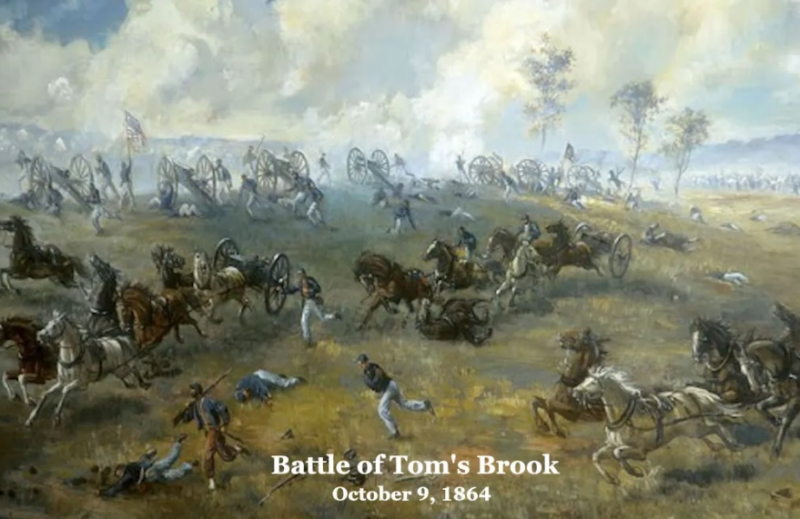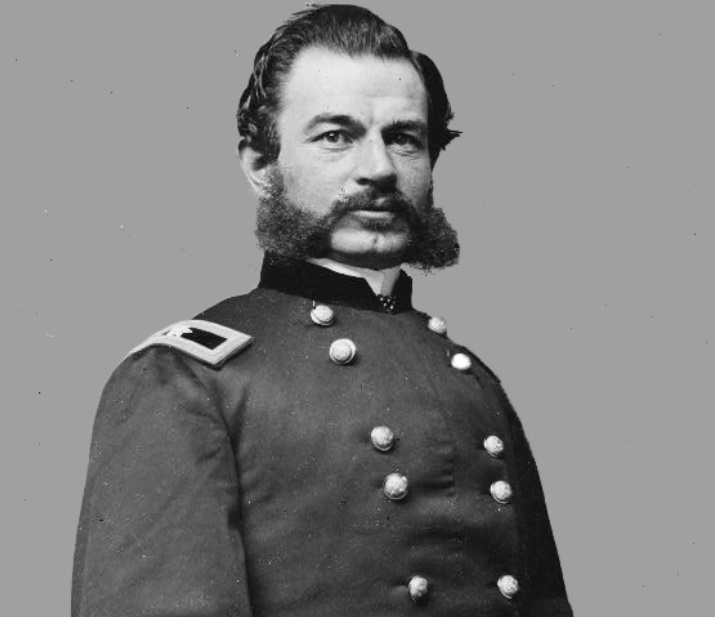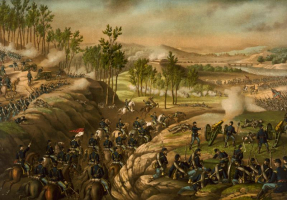Top 3 Facts About The Battle of Tom's Brook
The Battle of Tom's Brook took place on October 9, 1864, in Shenandoah County, Virginia, as part of Philip Sheridan's American Civil War Shenandoah Valley ... read more...Campaign. It resulted in a significant Union victory, termed The Woodstock Races because of the rapidity with which the Confederates withdrew. Here are some facts about the battle of Tom's Brook that you should know.
-
An interesting fact is that the battle of Tom's Brook is regarded as the most decisive Union cavalry victory in the Eastern Theater. The Confederate cavalry forces in the Eastern Theater outfought and outclassed their Union counterparts throughout much of the American Civil War. Confederate cavalrymen picked up the win after victory, led by aggressive and capable leaders such as J.E.B. Stuart, Wade Hampton, Fitzhugh Lee, John Mosby, "Grumble" Jones, and others.
Maj. Gen. Philip Sheridan pursued Jubal A. Early's Confederate force through the Shenandoah Valley to near Staunton after his victory at Fisher's Hill. Sheridan began evacuating his cavalry on October 6, burning everything of military consequence, including barns and mills. Early followed, bolstered by Maj. Gen. Joseph B. Kershaw's division. Maj. Gen. Thomas L. Rosser arrived from Petersburg to command Maj. Gen. Fitzhugh Lee's Confederate cavalry division was harassing the fleeing Federals. On October 9, Union troops turned on their pursuers, defeating the divisions of Rosser, whose cavalrymen were repulsed by Custer in a flanking move around the base of Spiker's Hill off Back Road, and Lunsford L. Lomax, who was positioned near the Valley Pike, at Tom's Brook.
A reinvigorated Federal cavalry arm proved to be the better battlefield force, led by new, young, and aggressive leaders such as Phil Sheridan, George Custer, Wesley Merritt, and David McM. Gregg. As a result, the Union cavalry achieved their most full and decisive victory of the Civil War at Tom's Brook.

shenandoahatwar.org 
battlefields.org -
One of the most interesting facts about the battle of Tom's Hook we compiled for you is that Tom's Brook came from Sheridan's wish to put an end to Confederate harassment of his Shenandoah Valley burning campaign. Early's withdrawal from Strasburg opened the way for Sheridan's scorched earth onslaught in the central Shenandoah Valley. Sheridan spent the following few weeks carrying out Grant's order to destroy the valley. Phil Sheridan launched his devastation campaign in the Shenandoah Valley on October 5, 1864. Sheridan had ordered his cavalry to fire and destroy mills, barns, and other agricultural supplies in their control, determined to eliminate the agricultural potential of the Shenandoah Valley once and for all. Sheridan stated that during "The Burning," he slaughtered thousands of sheep, hogs, and cattle and burnt 2,000 barns packed with wheat, hay, and farming instruments and over seventy mills filled with flour and wheat. Historian William Miller wrote: "the emotional impact of The Burning on Rosser and his men cannot be overestimated". Many Confederate horsemen were from the Shenandoah Valley and were outraged at the destruction of their farms and homesteads.
Confederate cavalry had been fighting Union detachments relentlessly in order to stop the destruction. This constant harassment of Union operations enraged Phil Sheridan, who eventually authorized an offensive to drive off the Confederate cavalry. This command resulted in the Battle of Tom's Brook.

apalacheresearch.com 
apalacheresearch.com -
One of the most interesting facts about the battle of Tom's Hook you should know is that the Confederate retreat was so quick that Union cavalrymen dubbed it the Woodstock Races. By October 6, Sheridan felt his reign of terror had come to an end, and he began moving his army north toward Cedar Creek. Confederate cavalry divisions led by Major Generals Thomas Rosser and Lunsford Lomax harassed the Union rearguard as the Federals advanced north. Dissatisfied with the Rebel attacks on the withdrawing Union troops, Sheridan directed his cavalry commander, Brigadier General Alfred Torbert, to either beat the enemy or get whipped. As a result, on October 9, Torbert directed two Union cavalry divisions led by brevet Major General Wesley Merritt and Brigadier General George A. Custer to turn and attack Confederate cavalry positioned along Tom's Brook near Woodstock, Virginia. The astonished Rebel troops briefly attempted to make a stand, but they were quickly galloping from the field. The Confederate retreat was so quick that Union cavalrymen dubbed it the Woodstock Races.
The Battle of Tom's Brook was a relatively small battle, with only 6,300 Federals and 3,500 Rebels taking part. Losses were relatively minimal, with the Union suffering 57 casualties and the Confederacy suffering 350. The Union win harmed the Rebel cavalry's morale and efficiency for the rest of the Shenandoah Valley Campaign in 1864.

essentialcivilwarcurriculum.com 
General A. T. A. Torbert -en.wikipedia.org
























